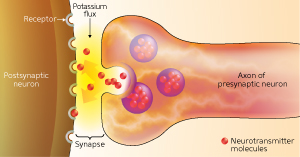Jan. 17, 2014 Research Highlight Biology
Amplifying communication between neurons
The leak of potassium ions into the synaptic cleft between neurons can amplify synaptic signaling
 Figure 1: Synaptic signaling occurs when neurotransmitter molecules (glutamate) released by the presynaptic neuron travel through the synaptic cleft to activate glutamate receptors, including NMDA receptors, on the postsynaptic neuron. Image courtesy of the National Institute on Aging
Figure 1: Synaptic signaling occurs when neurotransmitter molecules (glutamate) released by the presynaptic neuron travel through the synaptic cleft to activate glutamate receptors, including NMDA receptors, on the postsynaptic neuron. Image courtesy of the National Institute on Aging
Neurons send signals to each other across small junctions called synapses. Some of these signals involve the flow of potassium, calcium and sodium ions through channel proteins that are embedded within the membranes of neurons. However, it was unclear whether the flow of potassium ions into the synaptic cleft had a physiological purpose. An international team of researchers including Alexey Semyanov from the RIKEN Brain Science Institute has now revealed that potassium ions that leak out of channel proteins and spill into the synapse augment synaptic signaling between neurons, potentially fulfilling a reinforcement mechanism in learning and memory1.
Synaptic communication between neurons begins when calcium ions enter the axon terminal of one neuron—the presynaptic neuron—causing the release of neurotransmitter molecules, such as glutamate, which travel across the synaptic cleft and bind to receptor proteins on the surface of the receiving or postsynaptic neuron (Fig. 1). When the glutamate binds to a receptor known as the NMDA receptor, a channel in the receptor protein opens and calcium flows in, which initiates activation of the postsynaptic neuron.
Semyanov and his colleagues found that the opening of the NMDA receptor channel on the postsynaptic neuron also allows potassium ions to flow out of that neuron and into the synaptic cleft. Blocking the NMDA receptor prevented the rise in potassium ions within the synaptic cleft.
The NMDA receptor is generally blocked by magnesium ions, but these ions can be released from the receptor channel upon repetitive stimulation of the postsynaptic neuron. Through mathematical modeling and subsequent experiments, Semyanov and his colleagues found that potassium levels in the synaptic cleft could increase dramatically on removal of magnesium or during repeated activation of the postsynaptic neuron.
The rise in potassium in the synaptic cleft was shown to increase calcium entry into the presynaptic neuron axon terminal when the postsynaptic neuron was stimulated, and enhanced the probability that the glutamate neurotransmitter would be released from the presynaptic neuron. In this way, repeated activation of a given neuronal network, such as during learning, could augment the strength of communication between neurons, making it more likely that a given stimulus would trigger the activation of postsynaptic neurons.
"New memories are associated with long-term changes in synaptic strength following repetitive activation of the synapse, commonly known as synaptic plasticity," explains Semyanov. "Potassium accumulation and the consequent increase in probability of glutamate release can potentially aid the induction of synaptic plasticity, thus facilitating learning and memory," he says.
References
- 1. Shih, P.-Y., Savtchenko, L. P., Kamasawa, N., Dembitskaya, Y., McHugh, T. J., Rusakov, D. A., Shigemoto, R. & Semyanov, A. Retrograde synaptic signaling mediated by K+ efflux through postsynaptic NMDA receptors. Cell Reports 5, 941–951 (2013). doi: 10.1016/j.celrep.2013.10.026
